
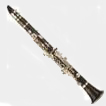
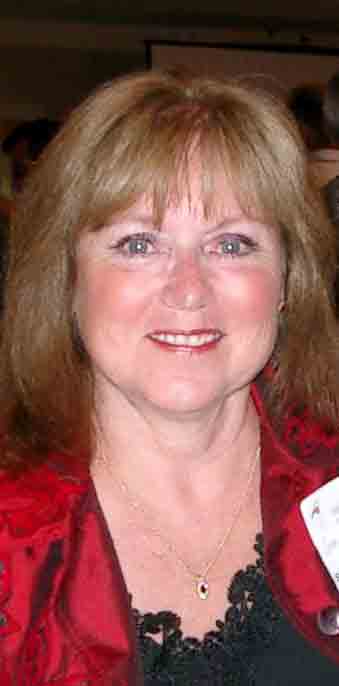
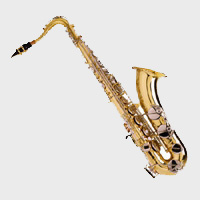
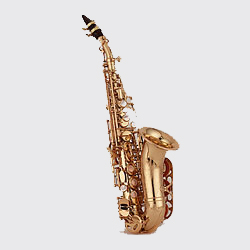

Clarinet Fingering Guide by Key
Copyright © 1995 by Joseph M. Izen
Mirrored by permission.
The first thing I did after purchasing my clarinet was
to hit the library for a fingering chart. To my chagrin, I found complex charts
encompassing the entire chromatic scale with non-intuitive key numbering systems and/or
extraneous information for simple fingerings. I may have a Ph.D. in physics, but my poor,
little brain was overloaded. I've tried a new approach. I've produced 15 fingering charts
arranged by key. I've devised a simpler, purely graphic representation of fingerings. Keys
or banks of keys are only shown if they are used for a particular note.
"Chromatic Fingering"


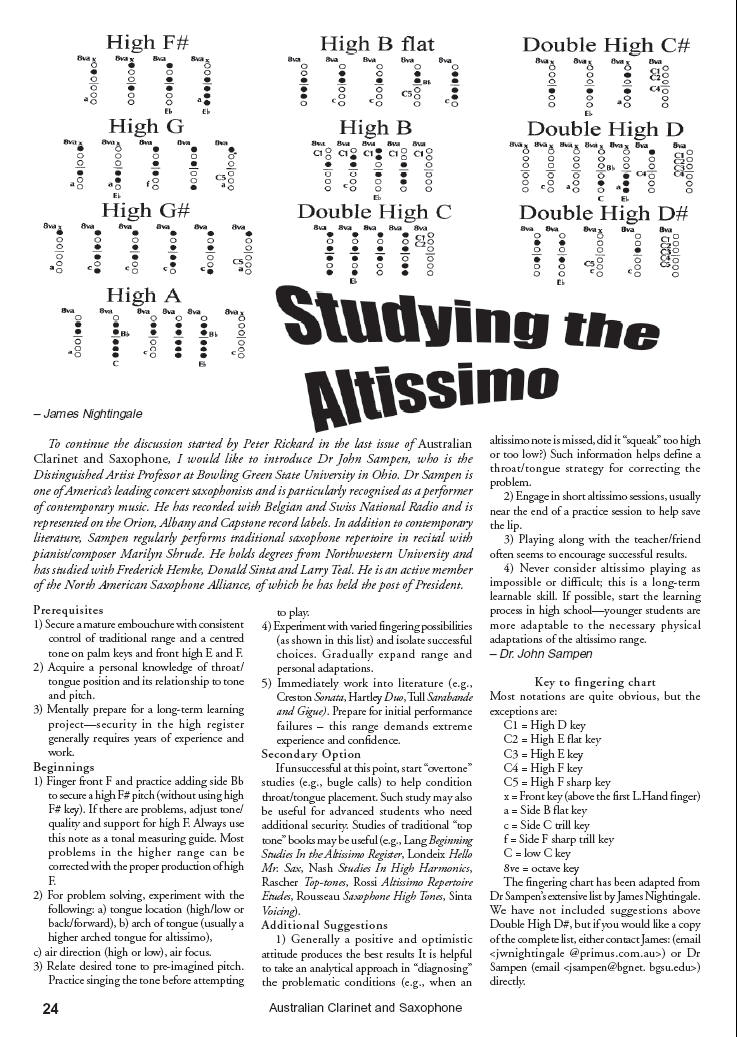
Tone Production for Beginning Saxophonists and Clarinetists

by Paul R. Coats
This handout is for teachers, the next step after teaching the student formation
of the embouchure:
This story was related to me by saxophonist and manufacturer Santy Runyon. Many years ago
a fellow approached Mr. Runyon where he was performing and said that he liked Mr. Runyon's
playing, but that Mr. Runyon played the sax wrong. Mr. Runyon was a little surprised,
since he practiced eight hours a day to develop his craft. The fellow invited Mr. Runyon
to his lab and assembled an alto saxophone. To this he attached a mouthpiece which had
been cut apart, leaving only the shank. To this mouthpiece shank he had attached a small
speaker, which was then connected to a Theramin (the first electronic synthesizer, often
heard in old horror movies and the Beach Boys "Good Vibrations"). The Theramin
was tuned so that the mouthpiece/speaker assembly produced the pitch of A, 880 Hz. Then,
when the mouthpiece/speaker was placed on the alto sax, the entire range of the saxophone
could be played by just fingering the notes. If tuned to a pitch much below A, 880 Hz,
only the low register would speak. If tuned much above A, 880 Hz, only the upper register
would speak. But when tuned to A, 880 Hz, both upper and lower register would speak.
Scientific foundation:
Mr. Runyon realized that it was not the air moving through the
instrument that made the tone, as it was obvious no air could move through this
sax/speaker/Theramin setup. It was the reed, driven by the air stream, that excited the
air column in the instrument to produce the tone. This is known as a "standing
wave" for you scientific types. There is a demonstration in Larry Teal's "The Art of Saxophone
Playing" which shows a 1" square of tissue paper floating in the bell of a
sax while the player plays a low Bb. No matter how hard the player blows, he is unable to
blow the tissue square from the bell of the sax. This tissue square is anchored in place
by the standing wave.
Technique:
Mr. Runyon found that if the mouthpiece and reed only are blown, and
the player can produce the A, 880 Hz (for the alto saxophone), then the correct embouchure
tension, bite, and airstream velocity are being used. The following method was developed
for teaching beginners and correcting embouchure problems.
Method:
Teach the student to assemble the mouthpiece, reed, and ligature
correctly. Only the mouthpiece assembly will be used for the first few weeks. Show the
student that there is a curve to the facing which allows the reed room to vibrate. Find
the fulcrum point of the facing by slipping an index card between the reed and mouthpiece.
The fulcrum point is the point at which the card stops. With a pencil, lightly draw a line
across the reed even with the edge of the card. Show the student how to form the sax or
clarinet embouchure. Using the thumb as a stop lined up with the pencil mark on the reed,
insert the mouthpiece until the thumb touches the lower lip. This will be very close to
the correct amount of bite. Have the student blow the mouthpiece. If the tone is squawky
and uncontrolled, use less mouthpiece. If the tone is choked off, or not produced at all,
insert more mouthpiece. For alto sax, have the student match the concert A, 880 Hz that
you play on the piano or keyboard (this is the A one octave and a sixth above middle C).
For the Bb soprano clarinet, match the concert B one step above the A, 880 Hz. For the
tenor sax, match the G one step below the A, 880 Hz. For baritone sax, match concert Eb.
For soprano sax, match Db two octaves and a half step above middle C on the piano.
Clarinet
Do you have a young clarinetist who has trouble playing above high C?
Have him play the concert B (his altissimo C#) on the mouthpiece only. You have just
proven to him that the reed will vibrate fast enough. Now, using the exact same
embouchure, he can play the high C# on his clarinet. Hint: Do NOT lift the first finger,
left hand, all the way off the tone hole in the altissimo (or third) register of the
clarinet. What you are doing with the first finger is forming a second register vent.
While playing fourth space E, roll the first finger down to just slightly crack a vent
("half-hole"). If the embouchure is correct, the high C# will pop right out. Now
play top line F, roll the finger down, and high D pops out. Play F#, roll the finger down,
out pops high Eb, etc. You may demonstrate this by turning the mouthpiece around and
letting the student blow while you finger the notes. There is no change in embouchure
tension from register to register. Biting to squeeze out the high notes is detrimental to
clarinet (and sax). With this demonstration it can be seen by all that the embouchure is
the same for the entire range of the clarinet. (Exception: For the upper register of the
bass clarinet, it is helpful to drop the jaw slightly.)
As aside: Many youngsters blame the reed or embouchure for squeaks,
when in reality it is usually poor hand and finger position. A tone hole may be slightly
cracked, forming an unneeded register vent, or the hand may be slightly opening a side
key. There may be a leaky pad. The young player squeaks, and then starts doing weird
things with his embouchure trying to stop the squeaks. When the student squeaks, he should
first check his hand position.
Saxophone
Use the "flick trick" to check embouchure tension. Have the
student play his second space A. The student closes his eyes (so he can't anticipate) and
the teacher operates the octave key. If the upper register does not speak, or is flat and
soggy, then the embouchure is too loose. If the upper A responds, but does not drop down
to the low A when the octave key is released, then the embouchure is too tight. It is OK
if there is a little hesitation dropping back down. If both octaves speak readily, the
embouchure tension is just right.
The student should not drop or pull back the jaw for the low notes, nor
should he bite for the high notes. The teacher or another saxophonist stands behind the
student and fingers the notes while the student blows the mouthpiece with the same
embouchure tension as is used to produce the proper pitch on the mouthpiece only. The
entire range of the sax can be played, with the possible exception of high E and F (these
notes require a slightly arched tongue position). If the low notes do not speak, the sax
may need adjustment. Check that the G# pad does not crack open when playing low C#, B, or
Bb. Doping the pads helps low register playing by sealing up little leaks.
The palm key notes and altissimo register require an altered oral
cavity. This is accomplished by arching the tongue up into an "EEE" position,
producing a faster airstream. (On soprano sax, this altered oral cavity is begun around
high C. Tenor and bari sax require less of this alteration for high E and F, but do
require arching the tongue for the altissimo register.)
© 1999-2005 Harri Rautiainen
and respective authors
www.saxontheweb.net
Legal Stuff
This file and the files linked from it are Copyright © 1995 by Joseph M. Izen and are
made available as a service to the Internet community. They may not be sold on disk, tape,
CD-ROM, packaged or incorporated with any commercial product, published in print, or
distributed by music teachers to their students without the explicit, written permission
of the copyright holder. Permission is hereby granted to make one printed copy of these
pages for your own personal use. Reasonable offers will be considered for non-personal
use, and for higher resolution reproductions of these charts.
License is hereby granted to redistribute on electronic
or other media for which no fees are charged (except for the media itself), so long as the
text of this copyright notice and license are attached intact to any and all republished
portion or portions.












